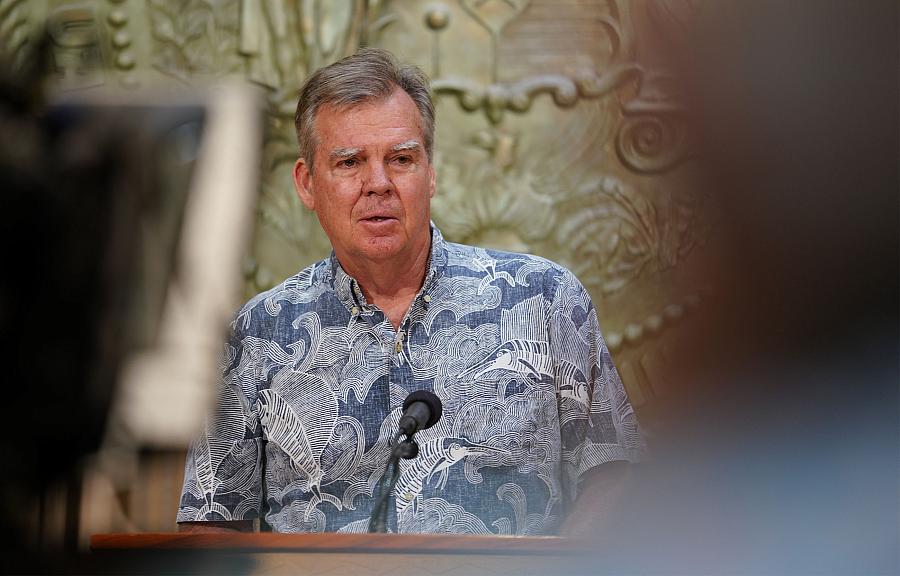Pandemic is disproportionately hurting Hawaii's Pacific Islander and Filipino communities

Bruce Anderson, Hawaii's health director.
(Photo by Cory Lum/Civil Beat)
In early April, Hawaii’s health director Bruce Anderson stood before reporters and answered a question about why the state hadn’t yet posted any data on racial disparities in COVID-19 cases.
He said the state was working on it, but he didn’t expect to see the disparities that exist on the mainland.
“I don't think we're going to find that here,” he said. “I think everyone is pretty much (in) the same socio-economic group, except perhaps some of the Native Hawaiians and Pacific Islanders.”
That’s a significant understatement. Despite Hawaii’s reputation as a racial paradise, the state is home to striking income disparities that fall along racial and ethnic lines. A 2018 statewide study found that for Hawaii’s Japanese and Okinawan families, poverty rates were below 4%. For Filipino families, the poverty rate was 7.5%. About a fifth of Samoan families lived in poverty, along with nearly half of Marshallese families.
COVID-19 in Hawaii hasn’t been as pervasive as in many other states — as of August 3, the Aloha State had about 2,500 confirmed coronavirus cases and 26 deaths. But even with relatively low numbers thus far, disparities persist.
The most recent data available shows that non-Hawaiian Pacific Islanders — Indigenous peoples of other islands in Polynesia, Micronesia and Melanesia — make up about 4% of Hawaii’s population but comprise 27% of confirmed coronavirus cases. Filipinos make up 16% of the population but account for 18% of cases. Those numbers are particularly worrisome given the relatively high rates of diabetes and heart disease in those communities.
Many Pacific Islanders and Filipinos work in front-line jobs and live in large multi-generational households, increasing their risk of catching the virus. Compounding the situation is the fact that many Pacific Islanders and Filipinos aren't U.S. citizens and lack access to critical economic and health care safety nets.
In Hawaii, the broader impact of the pandemic has been economic: with the collapse of tourism, the state’s biggest industry, the state’s unemployment rate jumped from around 2% to 22%. A recent Census survey found more than half of Hawaii residents lost income due to the pandemic and a quarter have been unable to pay rent. The state recently reported paying out more than $2 billion in unemployment insurance to about 150,000 people who filed claims.
But the communities that are getting hit hardest by COVID-19 are also struggling to benefit from that economic support. Immigrant leaders and advocates say the state has failed to provide adequate interpreter and translation services, making it harder for people who don't speak English to file for unemployment. Meanwhile, community leaders scramble to make their own translations of ever-changing health announcements.
Pacific migrants from Palau, the Marshall Islands and the Federated States of Micronesia in particular have struggled to get relief as Hawaii’s unemployment application web form originally excluded their legal migration status.
A recent data analysis found Pacific Islanders and Filipinos are also currently facing the highest rates of food insecurity in Hawaii. 44% percent of Pacific Islanders and 43% of Filipinos in Hawaii are experiencing food insecurity compared with 22% of the population statewide.
Local public health advocates Angel Lynn Talana and Sydney Unciano recently wrote in Civil Beat that a third of registered nurses in Hawaii are Filipino, potentially increasing their exposure to the virus.
“’Bahala na,’ which can be loosely translated to “whatever will be, will be,” is a cultural value often used in times of hardship where Filipinos will resign themselves to the situation,” they said. “This resilient mindset can be concerning because Filipinos will continue to work on the frontlines to fight this pandemic despite increased risks.”
As the virus hits Pacific communities, there’s an added layer of cultural grief. The way that the virus strikes the elderly is particularly painful for Pacific Islanders, who look to elders to hold traditional knowledge that, for so many Indigenous people, has been lost.
“It worries me because this comes after our elders, the people who hold our language and our stories,” one Samoan woman told me. “As someone who is still learning my ancestral language I worry about what this is doing for our future generations.”
My 2020 National Fellowship project will explore the racial and ethnic disparities in the COVID-19 pandemic in Hawaii and examine what the state could do to better help these communities. I’ll look at how other states are tackling similar disparities and explore potential solutions. I’ll interview Pacific Islander and Filipino families to learn about what information they’re missing from the news media and seek to provide helpful information translated into multiple languages.
